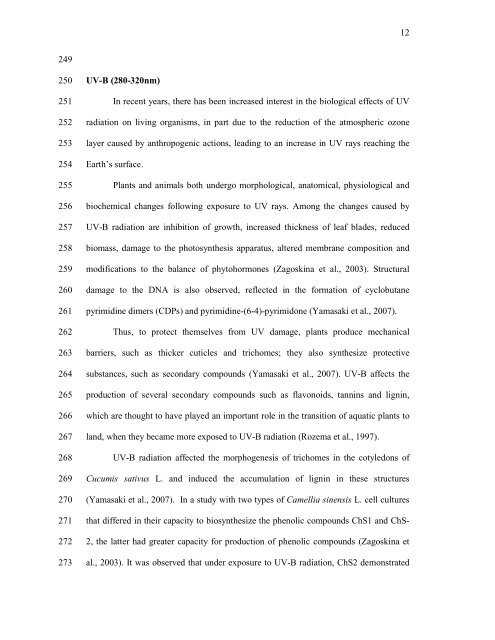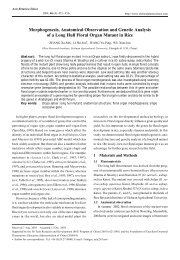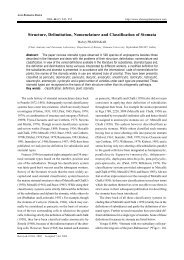Abiotic and biotic stresses and changes in the lignin ... - ResearchGate
Abiotic and biotic stresses and changes in the lignin ... - ResearchGate
Abiotic and biotic stresses and changes in the lignin ... - ResearchGate
You also want an ePaper? Increase the reach of your titles
YUMPU automatically turns print PDFs into web optimized ePapers that Google loves.
12<br />
249<br />
250<br />
251<br />
252<br />
253<br />
254<br />
255<br />
256<br />
257<br />
258<br />
259<br />
260<br />
261<br />
262<br />
263<br />
264<br />
265<br />
266<br />
267<br />
268<br />
269<br />
270<br />
271<br />
272<br />
273<br />
UV-B (280-320nm)<br />
In recent years, <strong>the</strong>re has been <strong>in</strong>creased <strong>in</strong>terest <strong>in</strong> <strong>the</strong> biological effects of UV<br />
radiation on liv<strong>in</strong>g organisms, <strong>in</strong> part due to <strong>the</strong> reduction of <strong>the</strong> atmospheric ozone<br />
layer caused by anthropogenic actions, lead<strong>in</strong>g to an <strong>in</strong>crease <strong>in</strong> UV rays reach<strong>in</strong>g <strong>the</strong><br />
Earth’s surface.<br />
Plants <strong>and</strong> animals both undergo morphological, anatomical, physiological <strong>and</strong><br />
biochemical <strong>changes</strong> follow<strong>in</strong>g exposure to UV rays. Among <strong>the</strong> <strong>changes</strong> caused by<br />
UV-B radiation are <strong>in</strong>hibition of growth, <strong>in</strong>creased thickness of leaf blades, reduced<br />
biomass, damage to <strong>the</strong> photosyn<strong>the</strong>sis apparatus, altered membrane composition <strong>and</strong><br />
modifications to <strong>the</strong> balance of phytohormones (Zagosk<strong>in</strong>a et al., 2003). Structural<br />
damage to <strong>the</strong> DNA is also observed, reflected <strong>in</strong> <strong>the</strong> formation of cyclobutane<br />
pyrimid<strong>in</strong>e dimers (CDPs) <strong>and</strong> pyrimid<strong>in</strong>e-(6-4)-pyrimidone (Yamasaki et al., 2007).<br />
Thus, to protect <strong>the</strong>mselves from UV damage, plants produce mechanical<br />
barriers, such as thicker cuticles <strong>and</strong> trichomes; <strong>the</strong>y also syn<strong>the</strong>size protective<br />
substances, such as secondary compounds (Yamasaki et al., 2007). UV-B affects <strong>the</strong><br />
production of several secondary compounds such as flavonoids, tann<strong>in</strong>s <strong>and</strong> lign<strong>in</strong>,<br />
which are thought to have played an important role <strong>in</strong> <strong>the</strong> transition of aquatic plants to<br />
l<strong>and</strong>, when <strong>the</strong>y became more exposed to UV-B radiation (Rozema et al., 1997).<br />
UV-B radiation affected <strong>the</strong> morphogenesis of trichomes <strong>in</strong> <strong>the</strong> cotyledons of<br />
Cucumis sativus L. <strong>and</strong> <strong>in</strong>duced <strong>the</strong> accumulation of lign<strong>in</strong> <strong>in</strong> <strong>the</strong>se structures<br />
(Yamasaki et al., 2007). In a study with two types of Camellia s<strong>in</strong>ensis L. cell cultures<br />
that differed <strong>in</strong> <strong>the</strong>ir capacity to biosyn<strong>the</strong>size <strong>the</strong> phenolic compounds ChS1 <strong>and</strong> ChS-<br />
2, <strong>the</strong> latter had greater capacity for production of phenolic compounds (Zagosk<strong>in</strong>a et<br />
al., 2003). It was observed that under exposure to UV-B radiation, ChS2 demonstrated







